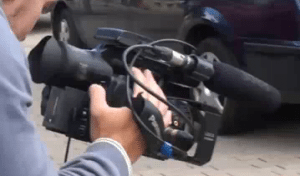 As television newsrooms expect more of their journalists to work solo, the trend is affecting both the process of newsgathering and the product that goes on the air. Many news managers believe VJs offer more flexibility at a lower cost with little or no reduction in quality. But new research suggests it’s not all good news.
As television newsrooms expect more of their journalists to work solo, the trend is affecting both the process of newsgathering and the product that goes on the air. Many news managers believe VJs offer more flexibility at a lower cost with little or no reduction in quality. But new research suggests it’s not all good news.
Mary Bock of Kutztown University spent two years studying the VJ revolution. Her unpublished dissertation highlights many of the challenges faced by journalists who report, shoot, write and edit. Some may be obvious: It’s tough to do this kind of physical work and still look good at 5 p.m., one VJ told her.
A bigger concern is what Bock’s analysis reveals about how the use of VJs is changing the content of TV news.
Pre-planned stories
“Because they work alone, VJs will be more apt to look for quick and easy access to story elements,” Bock writes. “Instead of the smaller cameras and simpler software making it easier to take chances, television VJs see themselves as having less freedom to take chances with their stories.”
So, Bock says, the trend toward using VJs for daily news has resulted in more stories that are mapped out–or even written–in advance. “It‘s not like the old days when you‘d go out and see what was actually happening and then decide how to cover it,” one VJ told Bock.
VJs who work for television organizations and must deliver a package a day, every day complained that they are unable to contend with heavier, hard news materials, and spend more of their time covering easy, one-location feature stories. This contradicts what some of the managers interviewed for this project perceived as a positive characteristic of video journalism. Managers who favor singular production see VJs are more easily deployed and better able to cover spot news, especially when two or three are sent to cover multiple angles of a hard-news story. That may well be. But based on the interviews and observations of the television VJs who participated in this project, their day-to-day experience seems one of a constant struggle to be taken seriously, not only in terms of their technical skills but the types of stories they cover.
Physical challenges
Another struggle for many VJs is the physical strain of working alone. “This is a craft that demands not only intellectual capacity but real physical stamina and a lot of people are not going to be able to do this simply because they haven‘t got the stamina,” one VJ says. And Bock reports that the National Union of Journalists in England is starting to hear health complaints–such as exhaustion or back problems–from VJs who have been on the job a few years.
There’s also the problem of doors.
As mundane as they are, doors pose problems for VJs because their hands are nearly always full, and they have no partner. Getting through a door with the equipment, and protecting the equipment from being damaged by a slamming door, is a daily challenge. (One VJ reports a new appreciation for automatic doors!)
Bock’s research does point to some advantages for VJs. Smaller cameras are less intimidating so interview subjects open up more easily, and solo journalists can gather elements for stories when they’re out and about, without having to worry about scheduling a photographer.
But she also finds that solo journalists can’t do the same work as quickly as a team of two, which has led some news managers to reassess the value of VJs. One manager said he’d rather have two people do more, and do it quickly. “I‘m not saying it‘s completely worthless,” he told Bock, “I‘m just saying for day in, day out, where the rubber meets the road – not happening.”









23 Comments
I’d have to disagree with the idea that VJ’s are more scripted than traditional production teams. I’ve been a VJ/Citizen Journalist for three years now. And I was given tremendous freedom by MTV News (Street Team ’08) and CNN iReport to go out and stumble upon great content and then bring it back. Being in a pool of 51 VJs for MTV and thousands for CNN, I had no expectations so I literally could just follow my nose. But it takes instinct and editorial judgment to get Web 2.0-prime content, perhaps something other VJ’s have lacked but were hired because of a keen technological skill set and ability to edit.
Interesting, Deborah, but there are marked differences in feelings, attitudes and abilities between those who used to gather news with two-person crews and those who’ve come up as VJs/MMJs. The reality is that the newsroom needs both, but I think you’ll see any negativity involving the VJ model fade with time. Of course, I also think we’re headed into an era of experimentation with finished product presentation, too, which may also factor into the matter. Best to you.